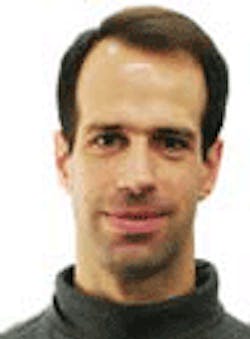Increasing Waterjet Cuttings Profitability, Part 1
Abrasives are still the largest cost driver of waterjet cutting, and anything shops can do to reduce abrasive consumption will have a great affect on cost per part.
Here are three ways to reduce abrasive consumption.
Tweak cutting equipment
First, shops should use smaller water nozzle/ abrasive nozzle combinations. Generally, shops cut with a 0.014-in. water nozzle and a 0.040-in. or 0.043-in. abrasive nozzle, running through anywhere from 1.2 lb to 2 lb of abrasive per minute. By reducing the water/ abrasive nozzle combination to 0.010 in./0.030 in., abrasive consumption drops to around 0.75 lb to 0.9 lb per minute.
However, most shops are loath to reduce the water/abrasive nozzle combination because it translates to fewer parts produced per hour. This is true, but not when a shop uses two cutting heads on their system.
Cutting with two heads and a smaller nozzle combination produces more parts per day and at a lower abrasive cost per part. Unfortunately, not all parts are suitable for 2-head cutting because of part size. But with 5 ft by 10-ft, or larger, machine tables, most shops find that the second head is usable for a large majority of the time.
As an example, if a shop cut with the 0.014 in./0.040-in. combination with one head at 20 ipm and 2 lb per minute of abrasive, that same shop, using the 0.010 in./0.030-in. setup could cut at 12 ipm and use only 1 lb per minute of abrasive for similar cut quality. However, the same shop using two heads could effectively cut at 24 ipm (2 X 12 ipm) and use 2 X 1 lb per minute.
At an abrasive cost of 25 cents per pound, the smaller nozzle combination gives a cost of $0.021 per inch. The cost of the larger combination would be $0.025 per inch. This is a savings of 16 percent per inch, and when a shop considers how much cutting it does in a year, these fractions of a penny add up quick.
When it comes to machine intensifier pumps, most are either 50 hp with 1.0 gpm of water output or 100 hp with 2.0-gpm output. The 50-hp pumps let shops run either one head with 0.014-in. water nozzle at 55,000 psi or two heads with 0.010 in. at 55,000 psi. The 100-hp pumps run either two heads at 0.014 in. at 55,000 psi or as many as four heads with 0.010 in. at 55,000 psi.
Another alternative is a 60-hp pump that puts out 1.2 gpm to 1.3 gpm. These pumps provide the advantage of running two heads with 0.011-in. water nozzles for slightly higher speeds than with a 0.010 in. while not having to significantly increase abrasive consumption, if at all, since a 0.030-in. abrasive nozzle is still used. Plus, 60-hp pumps use less electricity than a 100-hp one does.
Meter abrasive use
CNC abrasive metering is a second way to reduce abrasive consumption. These CNC abrasive metering systems allow shops to change the feedrate of abrasives during the cut and to choose between a “quality” cut and a “production” cut. Quality cuts use less abrasive than production cuts.
If a part requires high-quality cutting in a particular area, but the rest of it could be done with higher speed, lower quality cutting, a shop could save 0.2 lb to 0.4 lb per minute of abrasive using abrasive metering to cut the higher quality areas with less abrasive. Also, CNC abrasive metering allows shops to reduce the amount of abrasive used during the partpiercing process by 50 percent or more without increasing piercing time.
Keep a clean tank
Lastly, abrasive removal systems can reduce part cost by eliminating the downtime required to remove abrasive from a machine’s catcher tank. Abrasive removal systems automatically remove abrasive while the machine is cutting.
On a final note, if a shop’s cost of water is high, a closed-loop water recycling system can be used to cut costs. These systems also eliminate the potential for sewer lines to be clogged by abrasive that goes down the drain, and they improve the quality of the water going to the machine’s pump, so the pump lasts longer.
Look for Part II: Reducing Fixed Costs of Jeff Day’s guest editorial at American Machinist.com.
